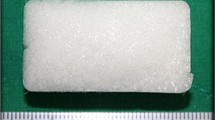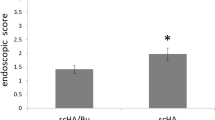Abstract
Adhesion is a major complication of endoscopic sinus surgery that may lead to recurrence of chronic rhinosinusitis, necessitating revision surgery. The purpose of this study was to evaluate the effect of hyaluronic acid and hydroxyethyl starch (HA–HES) relative to hyaluronic acid and carboxymethylcellulose (HA–CMC) with regard to anti-adhesion effect. In this multi-center, prospective, single-blind, randomized controlled study, 77 consecutive patients who underwent bilateral endoscopic sinus surgery were enrolled between March 2014 and March 2015. HA–HES and HA–CMC were applied to randomly assigned ethmoidectomized cavities after the removal of middle meatal packing. At the 1st, 2nd and 4th weeks after surgery, the presence and grades of adhesion, edema, and infection were, respectively, examined via endoscopy by a blinded assessor. The incidence and grades of adhesion at the 2-week follow-up were significantly less in the HA–CMC group than in the HA–HES group (p < 0.05). However, with the exception of week 2, there were no significant differences in the incidence or grades of adhesion, edema, and infection between the two groups. When the primary endpoint—the presence of adhesion at the 4-week follow-up—was compared between two groups, the incidence of adhesion in HA–HES group at the 4-week follow-up was 32% and in HA–CMC was 41.3%, indicating that HA–HES was not inferior to HA–CMC in terms of anti-adhesive effect. No severe adverse reactions were noted during the study period. In conclusion, HA–HES is a safe substitutional anti-adhesion agent that has equivalent effect as HA–CMC after endoscopic sinus surgery.

Similar content being viewed by others
References
Govindaraj S, Adappa ND, Kennedy DW (2010) Endoscopic sinus surgery: evolution and technical innovations. J Laryngol Otol 124:242–250
Kimmelman CP, Edelstein DR, Cheng HJ (2001) Sepragel sinus (hylan B) as a postsurgical dressing for endoscopic sinus surgery. Otolaryngol Head Neck Surg 125:603–608
Ramakrishnan VR, Kingdom TT, Nayak JV, Hwang PH, Orlandi RR (2012) Nationwide incidence of major complications in endoscopic sinus surgery. Int Forum Allergy Rhinol 2:34–39
Mendelsohn D, Jeremic G, Wright ED, Rotenberg BW (2011) Revision rates after endoscopic sinus surgery: a recurrence analysis. Ann Otol Rhinol Laryngol 120:162–166
Albu S, Baciut M (2010) Failures in endoscopic surgery of the maxillary sinus. Otolaryngol Head Neck Surg 142:196–201
Chung JH, Cosenza MJ, Rahbar R, Metson RB (2002) Mitomycin C for the prevention of adhesion formation after endoscopic sinus surgery: a randomized, controlled study. Otolaryngol Head Neck Surg 126:468–474
Masterson L, Tanweer F, Bueser T, Leong P (2010) Extensive endoscopic sinus surgery: does this reduce the revision rate for nasal polyposis? Eur Arch Otorhinolaryngol 267:1557–1561
Berlucchi M, Castelnuovo P, Vincenzi A, Morra B, Pasquini E (2009) Endoscopic outcomes of resorbable nasal packing after functional endoscopic sinus surgery: a multicenter prospective randomized controlled study. Eur Arch Otorhinolaryngol 266:839–845
Kim JH, Lee JH, Yoon JH, Chang JH, Bae JH, Kim KS (2007) Antiadhesive effect of the mixed solution of sodium hyaluronate and sodium carboxymethylcellulose after endoscopic sinus surgery. Am J Rhinol 21:95–99
Lee JH, Kim HK, Cinn YG, Chang J, Jung HH, Im GJ (2011) Anti-adhesive effect of Guardix-SL(R) after intact canal wall mastoidectomy: preliminary study. Korean J Audiol 15:14–18
Lee SA, Kim JS, Kim JS, Hwang JJ, Lee WS, Kim YH, Choi YK, Chee HK (2010) A study of the effect of a mixture of hyaluronic acid and sodium carboxymethyl cellulose (Guardix-sol(R)) on the prevention of pericardial adhesion. Korean J Thorac Cardiovasc Surg 43:596–601
Chung JH, Kang DH, Moon HS, Jeong TY, Ha US, Han JH, Yu JH, Park J, Cho JM, Yoo TK, Kim TH, Lee SW (2013) Effects of hyaluronic acid and carboxymethylcellulose on urethral stricture after transurethral resections of the prostate for benign prostatic hyperplasia: a multicenter, single blinded, randomized controlled study. J Endourol 27:463–469
Kozek-Langenecker SA (2005) Effects of hydroxyethyl starch solutions on hemostasis. Anesthesiology 103:654–660
Rossaint J, Berger C, Kraft F, Van Aken H, Giesbrecht N, Zarbock A (2015) Hydroxyethyl starch 130/0.4 decreases inflammation, neutrophil recruitment, and neutrophil extracellular trap formation. Br J Anaesth 114:509–519
Xie J, Lv R, Yu L, Huang W (2010) Hydroxyethyl starch 130/0.4 exerts its anti-inflammatory effect in endotoxemic rats by inhibiting the TLR4/NF-kappaB signaling pathway. Ann Clin Lab Sci 40:240–246
Burdick JA, Prestwich GD (2011) Hyaluronic acid hydrogels for biomedical applications. Adv Mater 23:41–56
Oh EJ, Park K, Choi JS, Joo CK, Hahn SK (2009) Synthesis, characterization, and preliminary assessment of anti-Flt1 peptide–hyaluronate conjugate for the treatment of corneal neovascularization. Biomaterials 30:6026–6034
Yeo Y, Highley CB, Bellas E, Ito T, Marini R, Langer R, Kohane DS (2006) In situ cross-linkable hyaluronic acid hydrogels prevent post-operative abdominal adhesions in a rabbit model. Biomaterials 27:4698–4705
Park JK, Yeom J, Hahn SK, Hwang EJ, Shin JS, Cho IH (2010) Anti-coagulating hydroxyethyl starch blended with hyaluronic acid as a novel post-surgical adhesion barrier. Macromol Res 18:1076–1080
Chang C, Hong SM, Cho JH, Shim SY, Cho JS, Lee HM (2014) A randomized, multi-center, single blind, active-controlled, matched pairs clinical study to evaluate prevention of adhesion formation and safety of hyfence in patients after endoscopic sinus surgery. Clin Exp Otorhinolaryngol 7:30–35
Valentine R, Athanasiadis T, Moratti S, Hanton L, Robinson S, Wormald PJ (2010) The efficacy of a novel chitosan gel on hemostasis and wound healing after endoscopic sinus surgery. Am J Rhinol Allergy 24:70–75
Baradaranfar MH, Khadem J, Zahir ST, Kouhi A, Dadgarnia MH, Baradarnfar A (2011) Prevention of adhesion after endoscopic sinus surgery: role of mitomycin C. Acta Med Iran 49:131–135
Ji GY, Oh CH, Moon BG, Yi S, Han IB, Heo DH, Kim KT, Shin DA, Kim KN (2015) Efficacy and safety of sodium hyaluronate with 1,4-butanediol diglycidyl ether compared to sodium carboxymethylcellulose in preventing adhesion formation after lumbar discectomy. Korean J Spine 12:41–47
Ward BC, Panitch A (2011) Abdominal adhesions: current and novel therapies. J Surg Res 165:91–111
Diamond MP, Burns EL, Accomando B, Mian S, Holmdahl L (2012) Seprafilm® adhesion barrier: (1) a review of preclinical, animal, and human investigational studies. Gynecol Surg 9:237–245
Leitao MM, Byrum GV, Abu-Rustum NR, Brown CL, Chi DS, Sonoda Y, Levine DA, Gardner GJ, Barakat RR (2010) Postoperative intra-abdominal collections using a sodium hyaluronate–carboxymethylcellulose (HA–CMC) barrier at the time of laparotomy for uterine or cervical cancers. Gynecol Oncol 119:208–211
Tabata T, Kihira T, Shiozaki T, Tanida K, Kondo E, Nagao K, Okugawa T, Sagawa N (2010) Efficacy of a sodium hyaluronate–carboxycellulose membrane (seprafilm) for reducing the risk of early postoperative small bowel obstruction in patients with gynecologic malignancies. Int J Gynecol Cancer 20:188–193
Massey CJ, Suh JD, Tessema B, Gray ST, Singh A (2016) Biomaterials in rhinology. Otolaryngol Head Neck Surg 154:606–617
Wang P, Gong G, Li Y, Li J (2010) Hydroxyethyl starch 130/0.4 augments healing of colonic anastomosis in a rat model of peritonitis. Am J Surg 199:232–239
Mráček A, Gřundělová L, Minařík A, Veríssimo LM, Barros MC, Ribeiro AC (2015) Characterization at 25 °C of sodium hyaluronate in aqueous solutions obtained by transport techniques. Molecules 20:5812–5824
Jacob A, Faddis BT, Chole RA (2002) MeroGel hyaluronic acid sinonasal implants: osteogenic implications. Laryngoscope 112:37–42
Miller RS, Steward DL, Tami TA, Sillars MJ, Seiden AM, Shete M, Paskowski C, Welge J (2003) The clinical effects of hyaluronic acid ester nasal dressing (Merogel) on intranasal wound healing after functional endoscopic sinus surgery. Otolaryngol Head Neck Surg 128:862–869
Johns DB, Keyport GM, Hoehler F, di Zerega GS, Intergel Adhesion Prevention Study Group (2001) Reduction of postsurgical adhesions with Intergel adhesion prevention solution: a multicenter study of safety and efficacy after conservative gynecologic surgery. Fertil Steril 76:595–604
Bork K (2005) Pruritus precipitated by hydroxyethyl starch: a review. Br J Dermatol 152:3–12
Wee JH, Lee CH, Rhee CS, Kim JW (2012) Comparison between Gelfoam packing and no packing after endoscopic sinus surgery in the same patients. Eur Arch Otorhinolaryngol 269:897–903
Hu KH, Lin KN, Li WT, Huang HM (2008) Effects of Meropack in the middle meatus after functional endoscopic sinus surgery in children with chronic sinusitis. Int J Pediatr Otorhinolaryngol 72:1535–1540
Antisdel JL, Matijasec JL, Ting JY, Sindwani R (2011) Microporous polysaccharide hemospheres do not increase synechiae after sinus surgery: randomized controlled study. Am J Rhinol Allergy 25:268–271
Acknowledgements
This study was supported by a grant from the Korean Health Technology R&D Project, Ministry of Health & Welfare, Republic of Korea (HI15C1512).
Author information
Authors and Affiliations
Corresponding authors
Ethics declarations
Conflict of interest
The authors declare that they have no conflict of interest.
Financial disclosures/funding
Clinical Research Fund from Shinpoong Pharm. Co., Ltd.
Ethics and approval
Ethics approval was obtained from the institutional review board of each participating institution (Korea University Medical Center IRB MD12034; Gangnam Severance Hospital IRB 3-2012-0280), and informed consent was obtained from all patients prior to enrollment.
Rights and permissions
About this article
Cite this article
Kim, SJ., Shin, JM., Lee, E.J. et al. Efficacy of hyaluronic acid and hydroxyethyl starch in preventing adhesion following endoscopic sinus surgery. Eur Arch Otorhinolaryngol 274, 3643–3649 (2017). https://doi.org/10.1007/s00405-017-4669-6
Received:
Accepted:
Published:
Issue Date:
DOI: https://doi.org/10.1007/s00405-017-4669-6




